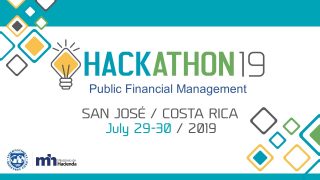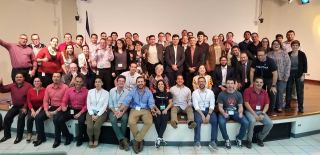
Posted by Gerardo Uña and Felipe Bardella[1]
The adoption of digital technology in public finance is expanding rapidly and has vast potential to improve public finance outcomes and strengthen fiscal institutions. The IMF’s Fiscal Affairs Department (FAD) and the Costa Rican Ministry of Finance organized the first public financial management (PFM) hackathon in Costa Rica on July 29-30. It focused on improving the Costa Rican payment system for social programs and promoting financial inclusion amongst beneficiaries, especially women. This event was supported by the Bill and Melinda Gates Foundation and facilitated by Disruptica, an artificial intelligence firm based in Washington, DC.
A hackathon is an event which harnesses innovative thinking to generate digital design solutions to specific challenges. It uses multi-disciplinary teams to analyze challenges, generate ideas, and build concrete innovative digital solutions. This hackathon’s main objective was to improve the efficiency, transparency and traceability of the payment system for social programs while promoting financial inclusion. This hackathon aimed to address the following two challenges:
- How to centralize the payment system at the National Treasury by verifying each payment against the existing central register (SINIRUBE) of social program beneficiaries and ensuring the traceability of all financial transaction
- How to transform the payment system for social programs through digital means (e.g., e-wallet) to ensure the beneficiaries (mostly women) can access goods and services in any commercial establishment (urban and rural). Additionally, the solution had to be compatible with the low capacity cell phones utilized in Costa Rica.

The hackathon attracted nearly 40 participants (software developers, economists, civil society experts, and international experts) who worked together to create prototypes to resolve these two challenges. The participants were organized into six groups, with three groups for each challenge. Different experts acted as mentors for the groups to ensure the delivery of an implementable solution.[2] A jury composed of the Minister of Finance, the Minister of Social Inclusion, FAD Deputy Director, a Gates Foundation official and a Corporacion Andina de Fomento (CAF) representative, selected the wining solutions which addressed the hackathon challenges.
Six solutions were developed to centralize the payment system at the National Treasury and to promote the financial inclusion of beneficiaries. All the solutions were presented in the form of operational prototypes developed with open source technology and they all achieved the pre-established technical requirements. Amongst them, the jury selected two winning solutions that utilized digital innovations, such as cloud architecture, microservices[3] and artificial Intelligence. These solutions could be implemented by the Ministry of Finance and the Ministry of Social Inclusion in a short period of time at an affordable cost (< $ 1 million). The main characteristics of the winning solutions are:
- “Vision 360”: An innovative solution to centralize, manage and control the payment system for social programs at the National Treasury. It was developed using the microservices IT technique and it can be easily scaled up, including with powerful parametrization[4] and reporting capabilities. The solution will dramatically reduce the time for a payment to reach beneficiaries from the current 3-5 days to just 24 hours. Also, the solution will verify each payment against the central beneficiaries’ database and notify them instantly through email, SMS or WhatsApp when payment has been processed.
- “Sury”: An App focused on improving the quality and timelines of payments through an e-wallet solution, which will promote the financial inclusion of beneficiaries. This app has different user interfaces (web app, SMS, WhatsApp, voice commands) allowing it to be used for day-to- day payments and to check bank account balances. Additionally, this app was designed to be downloaded on the low capacity cell phones operating in Costa Rica.
The prize for the winning teams is a trip to Washington DC to present their innovative solutions at the 2019 IMF’s Annual Meetings. FAD is supporting the Costa Rican authorities in future developing the winning prototypes and is coordinating with other development partners on this initiative.
Costa Rica’s PFM hackathon results are promising, testing this methodology in different institutional environments will help to refine the prerequisites and validate its results. This experience will enrich FAD’s future hackathons and help us to learn more about how Hackathons can complement more traditional capacity-building activities.
[1] Gerardo Uña is Senior Economist and Felipe Bardella is a Technical Assistance Advisor at Fiscal Affairs Department, IMF.
[2] These included Costa Rican government officials (from the Ministry of Finance, the Ministry of Social Inclusion, and the Central Bank), staff from the Inter-American Development Bank (IDB) and the Corporacion Andina de Fomento (CAF), representatives from the Ministries of Finance of Brazil and India as well as from civil society organization (Abriendo Datos) and from the Global Initiative for Fiscal Transparency.
[3] A software development technique that structures an information system as a collection of small services focused on just one specific functionallty, which must interact with each other. The benefit of breaking down an information system into different smaller services is that it improves the software modularity. See more details in https://blog-pfm.imf.org/pfmblog/2019/05/rethinking-the-design-of-fmiss.html
[4] The process of introducing specific data and parameters to satisfy the IT systems business and operational needs. For example, the introduction of the chart of account or the budget economic classification codes.
Note: The posts on the IMF PFM Blog should not be reported as representing the views of the IMF. The views expressed are those of the authors and do not necessarily represent those of the IMF or IMF policy.





